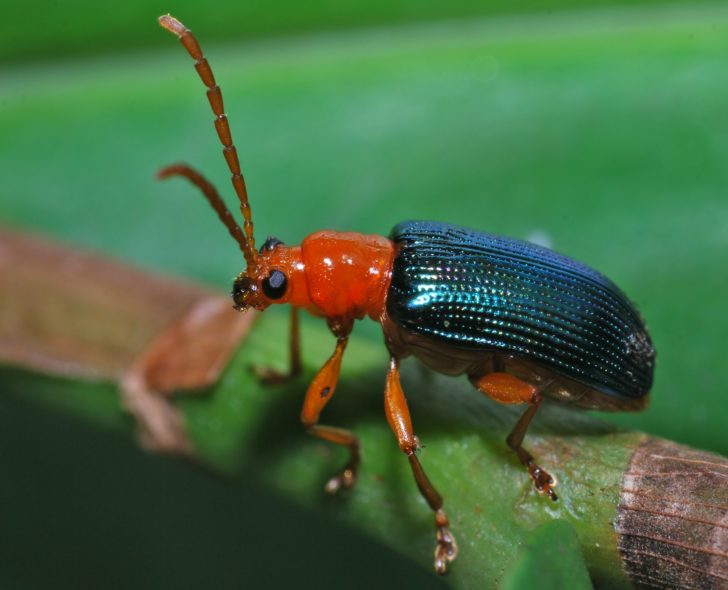Drawing inspiration from feet

A German research team has increased the adherence of silicone materials by imitating the feet of beetles.
Geckos, spiders and beetles garner attention from science because they can stick and walk on ceilings and walls, thanks to special adhering structures on their feet. In the field of bionics, scientists try to replicate and control these biological functions for technological use and materials. A team from the Christian-Albrechts-Universität zu Kiel (CAU) has now succeeded in enhancing the adherence of a silicone material by combining two methods. Drawing inspiration from the feet of beetles, they first designed the surface accordingly at the microscale. Subsequently, they treated the silicone material with plasma. An additional finding of this work is that the adherence of the structured material differs significantly when it is bent. These findings could be interesting for development of tiny robots and gripping devices. Synthetic elastic materials such as silicone elastomers are very popular in industries because they are flexible, cheap, easily produced and can be reused. For these reasons, they are often used in gaskets for insulation or to protect against corrosion. One big problem remains however: due to low surface energy, they do not stick well, therefore making it hard to paint silicone surfaces.
Better adherence with different microstructure
Inspired by the male leaf beetle (Chrysomelidae), Prof. Stanislav N. Gorb and Emre Kizilkan of the CAU investigated how the adherence properties of silicone elastomers can be enhanced by a surface structure in the form of a mushroom head. In two recent studies, they found that the silicon materials adhere best when their surface is structured this way and subsequently treated with plasma. Further results showed that the amount of bending influences the adherence property of this microstructured silicone material.
“Animals and plants often provide a wide range of fascinating properties. We want to transfer these to synthetic materials to control their behavior in a specific manner”, say zoologist Gorb. Their goal is to develop a reversible adherence at the micro scale that functions without any glue, which could be applied in various fields, for example microelectronics.
Bending of silicone surfaces
The research team looked at silicone elastomers with three different surfaces, one of which was mushroom-shaped. As a baseline comparison, they stuck a glass sphere onto the material and removed it again afterwards. They compared how the adherence changes when the microstructural surfaces are bent convexly (i.e. bent outwards) as opposed to bent concavely (i.e. bent inwards). “We were able to show, that those silicone elastomers with the mushroom heads bent concavely, exerted a two times larger spectrum of adherence strength”, PhD student Emre Kizilkan, lead author of the study, explained.
Variation in parameters during plasma treatment
In a second step, the silicone elastomers were treated with plasma, a method commonly used to functionalize synthetic materials for better adherence properties. Plasma treatment promises more longevity as compared to alternatives which employ liquids, but also pose the risk of damaging the material surfaces. To assess how plasma treatment can strongly enhance the adherence of a material without damaging it too much, the scientists varied parameters such as pressure and duration of the procedure. This led to the finding that plasma treatment on unstructured surfaces can increase the adherence up to 30%. On the mushroom heads and with optimized parameters however, this can become up to 91%. “This result was particularly surprising to us, because the structured surface is actually only half as large as the unstructured one. But after the plasma treatment it exhibited a threefold increase in adherence”, says Kizilkan. What exactly happens during the procedure is visible with a high-speed camera: Due to the higher surface energy, the microstructure treated with plasma completely holds contact with the glass carrier for 50.6 seconds. The contact area of the untreated microstructure on the other hand is quickly reduced by about one third – the material departs from the glass carrier in just 33 seconds.
Useful for many applications
Material scientist Kizilkan summarizes the findings: “we now have strong adherence on a small surface, which we can vary broadly”. This is particularly interesting for applications on a similarly small scale, like microrobots. One product that has already resulted from these findings is a strongly adhering tape, which works with the “gecko phenomenon” and can be taken off without any residue.
Source: http://www.chemie.de/news/1156871/auf-die-fuesse-geschaut.html?WT.mc_id=ca0259